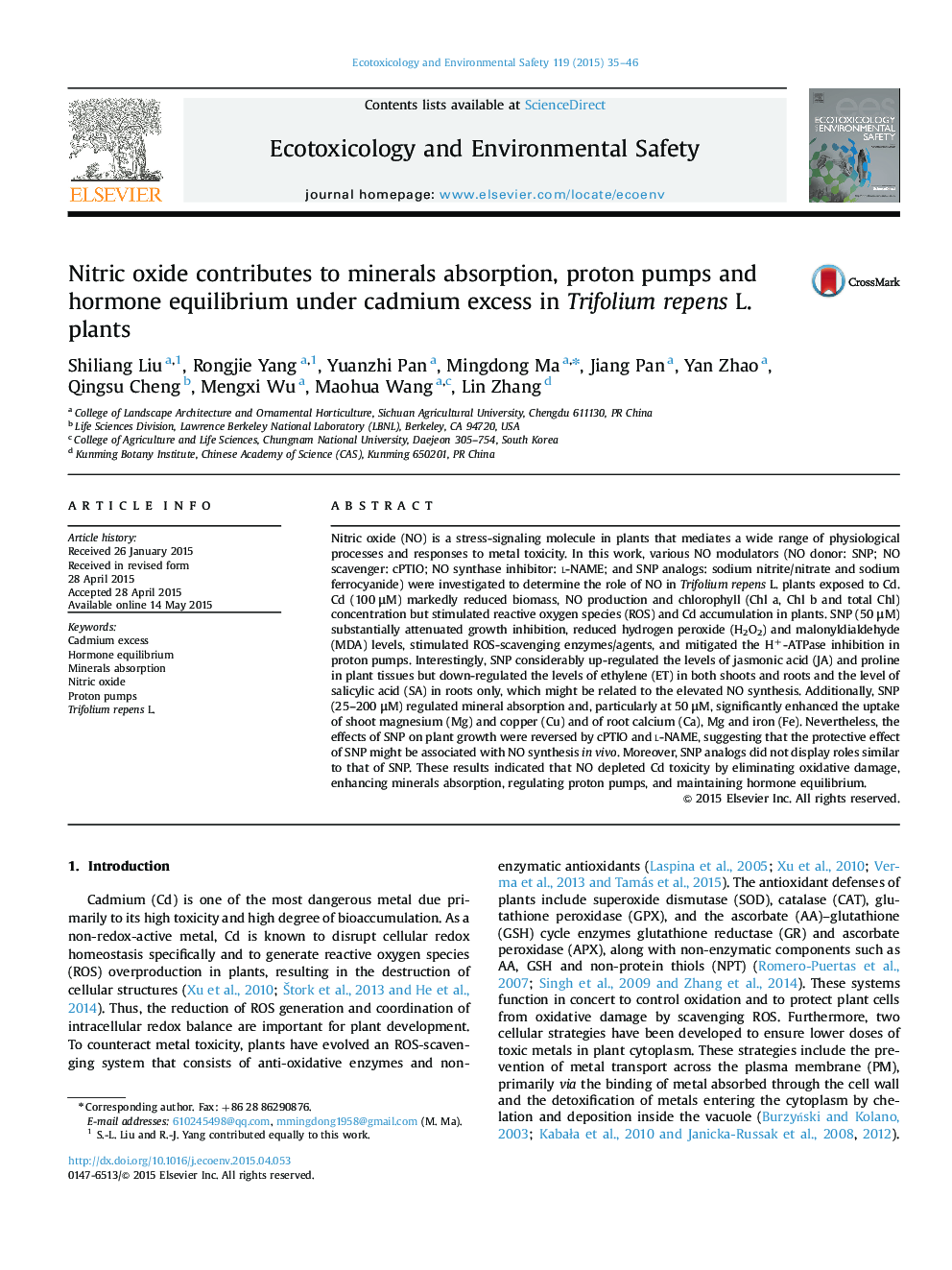| کد مقاله | کد نشریه | سال انتشار | مقاله انگلیسی | نسخه تمام متن |
|---|---|---|---|---|
| 4419612 | 1618944 | 2015 | 12 صفحه PDF | دانلود رایگان |

• 100 μM Cd markedly reduced the growth attributes of Trifolium repens L. plants.
• The accumulation of endogenous NO and ROS reveled reciprocal changes.
• SNP application depleted the deleterious effects of Cd on plant growth.
• SNP upregulated the levels of jasmonic acid (JA) and proline in Cd treated plants.
• The protective effects of SNP in plants were reversed by cPTIO and l-NAME.
Nitric oxide (NO) is a stress-signaling molecule in plants that mediates a wide range of physiological processes and responses to metal toxicity. In this work, various NO modulators (NO donor: SNP; NO scavenger: cPTIO; NO synthase inhibitor: l-NAME; and SNP analogs: sodium nitrite/nitrate and sodium ferrocyanide) were investigated to determine the role of NO in Trifolium repens L. plants exposed to Cd. Cd (100 μM) markedly reduced biomass, NO production and chlorophyll (Chl a, Chl b and total Chl) concentration but stimulated reactive oxygen species (ROS) and Cd accumulation in plants. SNP (50 μM) substantially attenuated growth inhibition, reduced hydrogen peroxide (H2O2) and malonyldialdehyde (MDA) levels, stimulated ROS-scavenging enzymes/agents, and mitigated the H+-ATPase inhibition in proton pumps. Interestingly, SNP considerably up-regulated the levels of jasmonic acid (JA) and proline in plant tissues but down-regulated the levels of ethylene (ET) in both shoots and roots and the level of salicylic acid (SA) in roots only, which might be related to the elevated NO synthesis. Additionally, SNP (25–200 μM) regulated mineral absorption and, particularly at 50 μM, significantly enhanced the uptake of shoot magnesium (Mg) and copper (Cu) and of root calcium (Ca), Mg and iron (Fe). Nevertheless, the effects of SNP on plant growth were reversed by cPTIO and l-NAME, suggesting that the protective effect of SNP might be associated with NO synthesis in vivo. Moreover, SNP analogs did not display roles similar to that of SNP. These results indicated that NO depleted Cd toxicity by eliminating oxidative damage, enhancing minerals absorption, regulating proton pumps, and maintaining hormone equilibrium.
The hypothetical scheme illustration for nitric oxide functions in the regulation of the white clover plants response to metals (Cd) cytotoxicity. “?” mark indicates that the route has not yet been resolved. Dashed box in the upper left corner indicates the defense mechanism of reactive oxygen species (ROS) and antioxidants involve in the response to metals stress in plants. Plants possess several enzymes involved in NO production which are: cytosolic nitrate reductase (NR), plasma-membrane (PM)-nitrite: NO reductase (Ni: NOR), nitric oxide synthase (NOS) and xanthine dehydrogenase (XDH).Abbreviations for enzymes or compounds/agents: AA–ascorbic acid; APX–ascorbate peroxidase; ATP–Adenosine triphosphate; Ca–calcium; CAT–catalases; Cd–cadmium; cGMP–cyclic guanosinc monophosphate; cPTIO-2-(4-carboxyphenyl)-4,4,5,5-tetramethylimidaz-oline-1-oxyl-3-oxide; Cu–copper; DHAR–dehydroascorbate reductase; ET–ethylene; Fe–iron; GPX–glutathione peroxidase; GR–glutathione reductase; GSH–glutathione; GSSG–oxidized glutathione; H2O2–hydrogen peroxide; JA–jasmonic acid; K–potassium; L-NAME–NG-nitro-L-Arg-methyl ester; MDAR–monodehydroascorbate reductase; Mg–magnesium; NADPH–triphosphopyridine nucleotide; NO–Nitric oxide; NPT–non-protein thiols; OH
• –hydroxyl radical; O2
• ––superoxide radicals; SA–salicylic acid; SNP–sodium nitroprusside; SOD–superoxide dismutase.Figure optionsDownload as PowerPoint slide
Journal: Ecotoxicology and Environmental Safety - Volume 119, September 2015, Pages 35–46